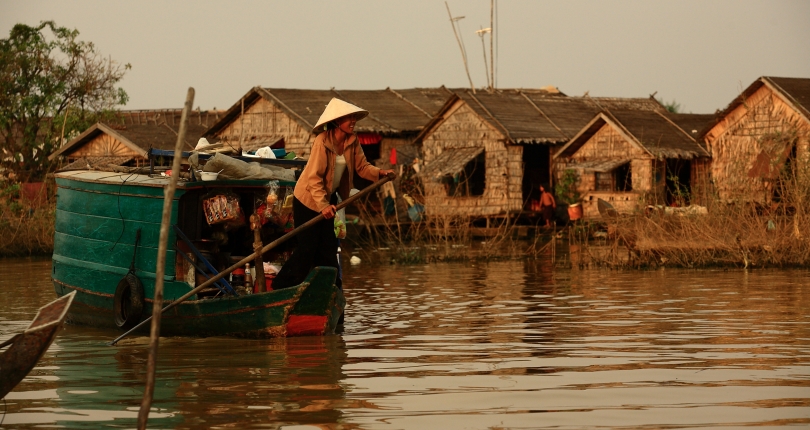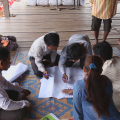Exploring the invisible: Women’s voices in Mekong water management
Water is life. For women, rivers are our soul. As water collectors, peasants, caretakers, and stewards of natural resources, women’s relationships with water throughout the life cycle are fundamental, yet too often invisible.
Nagarkot Statement, 2019
State of Knowledge: Women and Rivers in the Mekong Region
This report by International Rivers is where to start when trying to understand why, how and what women do in Mekong water decision-making and river governance. This thorough report, using interviews across the Mekong, clear academic structure, local voices, and a passion for change, is a hallmark report that will inform researchers, policy makers, NGOs and governments across the region in the coming decades.
The report provides a state of knowledge of women in river and water governance across the Mekong Region (Cambodia, China, Lao PDR, Myanmar, Thailand, Vietnam). Highlighting contributions—both actual and potential—to better governance, social, and environmental outcomes for rivers in the Mekong Region. It spotlights women’s achievements in water decision-making and river governance, but also the major barriers to their leadership and “visible” participation. Women are often not only more invisible because of gender norms but because they are also marginalized and poor. While it flags key points of inequity across the six countries of the Mekong Region, it also references good practice examples of women leadership. Highlighting that women are not powerless but that they are often made invisible through patriarchal norms that confine them to positions of marginalization.
Are you exploring the research gaps?
A key outcome from the report is the call for more work in exploring gaps in research, action and policy of women in water management. While many research projects ‘say’ they look at gender relations, it’s clear that there are five research gaps in the literature on gender and water governance in the Mekong Region that remain:
(1) measuring gender transformation and social norms change; (2) considering (feminist) political ecology and political economy linkages; (3) incorporating a regional perspective; (4) feeding scholarship back to communities to enhance local ownership and validation; and (5) defining the typologies of leadership in river governance and water decision-making.
What does this mean for Mekong research projects?
Even if you are not exploring a clear research gap in gender and development studies– the report highlights the essential role that gender plays across all water management decisions. So, if you have a project on Mekong water – it should address gender and social equality considerations. Many practical steps are identified, that research projects can do now to include women within ongoing work. Here are three practical pointers:
- To prevent gender inclusion from becoming mere box-ticking exercises, it is important that gender sensitivity is built into all stages of program or project design, development, and implementation to ensure that the necessary resources are allocated to relevant stakeholders and, in doing so, amplify inclusivity.
- Projects must ask women, from different social backgrounds and diverse identities, directly what kind of support they need, what skills they would like to develop, what government assistance they require, and how they would like to gain new skills and support.
- Women’s and indigenous knowledge do not always integrate seamlessly into what is seen as scientific research or empirical knowledge. They can also be undervalued or even delegitimized through laws and policies that render illegal traditional ways of knowing and doing. Dialogue and more research are thus needed to support the production of inclusionary knowledge within both the policy and academic spheres.
Finally, some projects, such as those funded by SUMERNET 4 All (S4A) focus on gender sensitivity. S4A mission is “to improve the policies and practices in reducing water insecurity by conducting collaborative research, engaging in the policy process, and promoting scientifically sound research and innovation while considering gender and social equality, human rights, conflict sensitivity, environmental integrity and poverty reduction in the Mekong Region.” This report is an excellent starting point for researchers to understand why, how and what can be done to ensure we respectfully explore the invisible women on the Mekong. Other sources such as the gender podcast or the gender guidelines are also available.
Info
This story is part of the following project
SUMERNET 4 All: Engaging with water insecurity in the Mekong Region
Related people
You might be interested in
-
SUMERNET Vision Guide introducing the new phase "SUMERNET 4 All"
The new, revised "Vision Guide" for SUMERNET is now available. This vision guide presents an overview of SUMERNET - its origins and governance structure, background to the network, aims, key research areas, engagement with policy, and outreach products
![SUMERNET Vision Guide introducing the new phase "SUMERNET 4 All"]()
-
SUMERNET 4 All Call for Proposals on Joint Action
SUMERNET 4 All (S4A) provides financial support and technical assistance to consortia of researchers and boundary partners from the Mekong Region
![SUMERNET 4 All Call for Proposals on Joint Action]()
-
SUMERNET launches redesigned website to provide a fresh visual look and direction
SUMERNET is proud to announce the launch of our redesigned website to coincide with our new phase of work on addressing water insecurity in the Mekong Region.
![SUMERNET launches redesigned website to provide a fresh visual look and direction]()
 By
By 



 Read more about SUMERNET
Read more about SUMERNET
